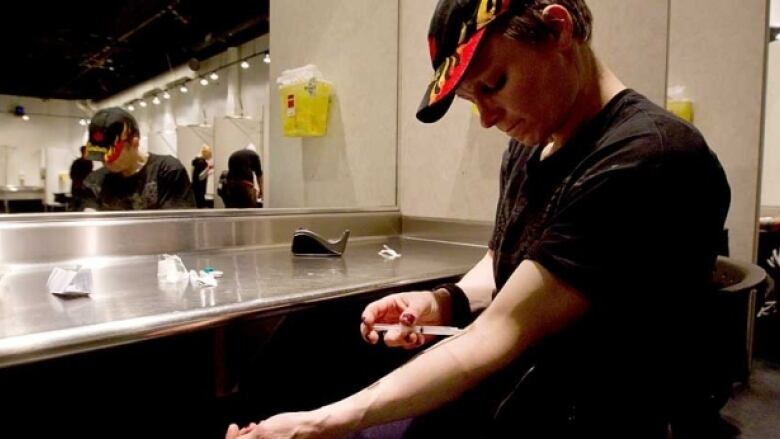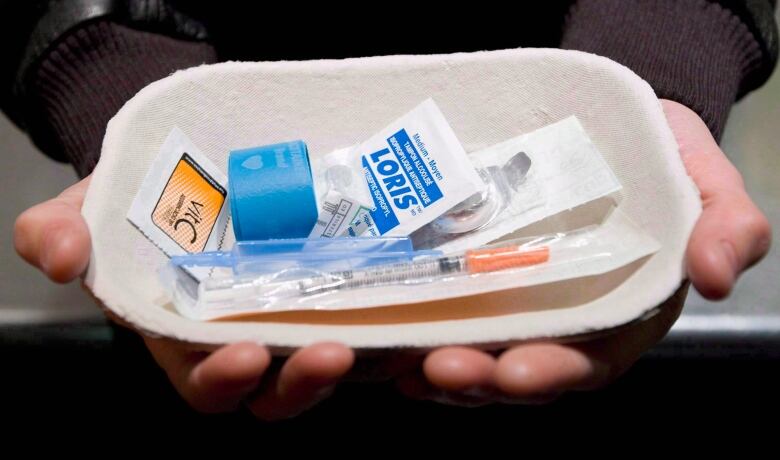City approves free crack pipes, moves towards safe injection site study
Shift comes as part of increased focus on local harm reduction strategy

The city of Hamilton is taking steps to becomea safer place for drug users.
On Monday, the board of healthapproved plans to offer clean crack pipes, expandHamilton's opioid overdose-reversing naloxone program, and begin exploringthe viability of local safe injection sites for intravenous drug users.
This isn't the same as condoning or supporting drug use this is about keeping people safe.- Dr. Jessica Hopkins,AssociateMedical Officer of Health
The official approval of the safe injection sites and the expansion of the naloxone program is contingent on a debate for the 2017 budget as costs were a sticking point for some.
Still, it's a decisive shift towards Hamilton Public Health's harm reduction strategy, which prizes the safety of drug usersover just about anything else.
- Opioid overdose deaths nearly double, as Hamilton's dead remembered
- Prescription painkiller abuse exploding in Hamilton
As Associate Medical Officer of Health Dr. Jessica Hopkins calls it, it's all about "meeting people where they're at."
"We want to keep people alive, or to keep them from getting or spreading disease," Hopkins said at Monday'smeeting.
"This isn't the same as condoning or supporting drug use this is about keeping people safe."
A move away from the war on drugs
So under this harm reduction strategy, what would Hamilton look like should all these measures come to fruition?
Well, city staff and agencies will hand out clean pipes for smoking crack (with costs covered by the province), as sharing them is known to spread HIV and hepatitis C.
This comes on top of the city's needle exchange program, which is already running. The city handed out about a million needles in 2015, and received about 600,000 back.
There would also be "supervised injection sites" (which are more commonly known as "safe injection sites"). There, intravenous drug users can bring in their drugs, and are supplied with clean needles to inject them.
We're going to get a lot of push back when people start realizing we're considering it.- Coun. Donna Skelly
Nurses are also on site to monitor in case of overdose. This would both cut down on overdose deaths (there are about 30 in Hamilton each year, and that number is a conservative estimate), as well as help withthe spread of bloodborne pathogens, Hopkins says.
It also helps eliminate used needles strewn around the city's dark corners and alleyways, she said.
There would also be an expansion of the city's naloxone program a drug that reverses the effects of an overdose long enough to get someone to hospital.
Over the past two years the city has distributed 582 of the kits for free to addicts and people close to them. The city says since then the kits have been used 148 times.
Support, but questions about costs
Largely, councilors were supportive of the initiatives. "We can either be proactive... or we can pretend on this approach of tough on crime, which we know doesn't work," Ward 3 Coun. Matthew Green said.
Ward 2 Coun. Jason Farr was also supportive, but cautioned that it's a safe bet that some residents would be crying "not in my backyard" about safe injection sites.
Hopkins said that the study on the issue would include community consultations about people's concerns, and how to mitigate them.
But not all councilors were supportive of every initiative. "I have trouble with this from a moral perspective," Ancaster Coun. Lloyd Ferguson said.

Ferguson, who chairs the city's police board, also talked about how this could be a quandary for police, seeing as drugs like heroin are illegal, and "here we are as a city, encouraging it."
Ward 7 Coun. Donna Skelly also had issues. "You're painting a very rosy picture," she told Hopkins. "And we're going to get a lot of push back when people start realizing we're considering it."
Skelly's main sticking point was the price of the initiatives. It would cost $250,000 in next year's budget for the supervised injection site study, as well as $260,956 more to expand the distribution of naloxone, which has prevented 116 deaths from opioid overdose in Hamilton since 2014.
If approved, it would cost about $1 million to $1.5 million to set up a safe injection site, Hopkins said, adding that annual costs are more difficult to predict at this stage.
If Hamilton eventually opens supervised injection sites, it will join Vancouver as one of two Canadian cities thatoffer the service, according to a staff report. Kamloops, B.C. also approved a supervised injection site this month.
Other cities, such as Toronto and Montreal, are looking at supervised injection sites but have yet to receive exemptions under the federal Controlled Drugs and Substances Act.
According a 15-year study of drug use in Vancouver's impoverished Downtown Eastside, harm reduction strategies like supervised injection sites have reduced illicit drug use and improved public safety.
The report by the B.C. Centre for Excellence in HIV/AIDS found that from 1996 to 2011, fewer people were using drugs and, of those who were, fewer were injecting drugs.
With files from The Canadian Press












_(720p).jpg)


 OFFICIAL HD MUSIC VIDEO.jpg)
.jpg)



























































































